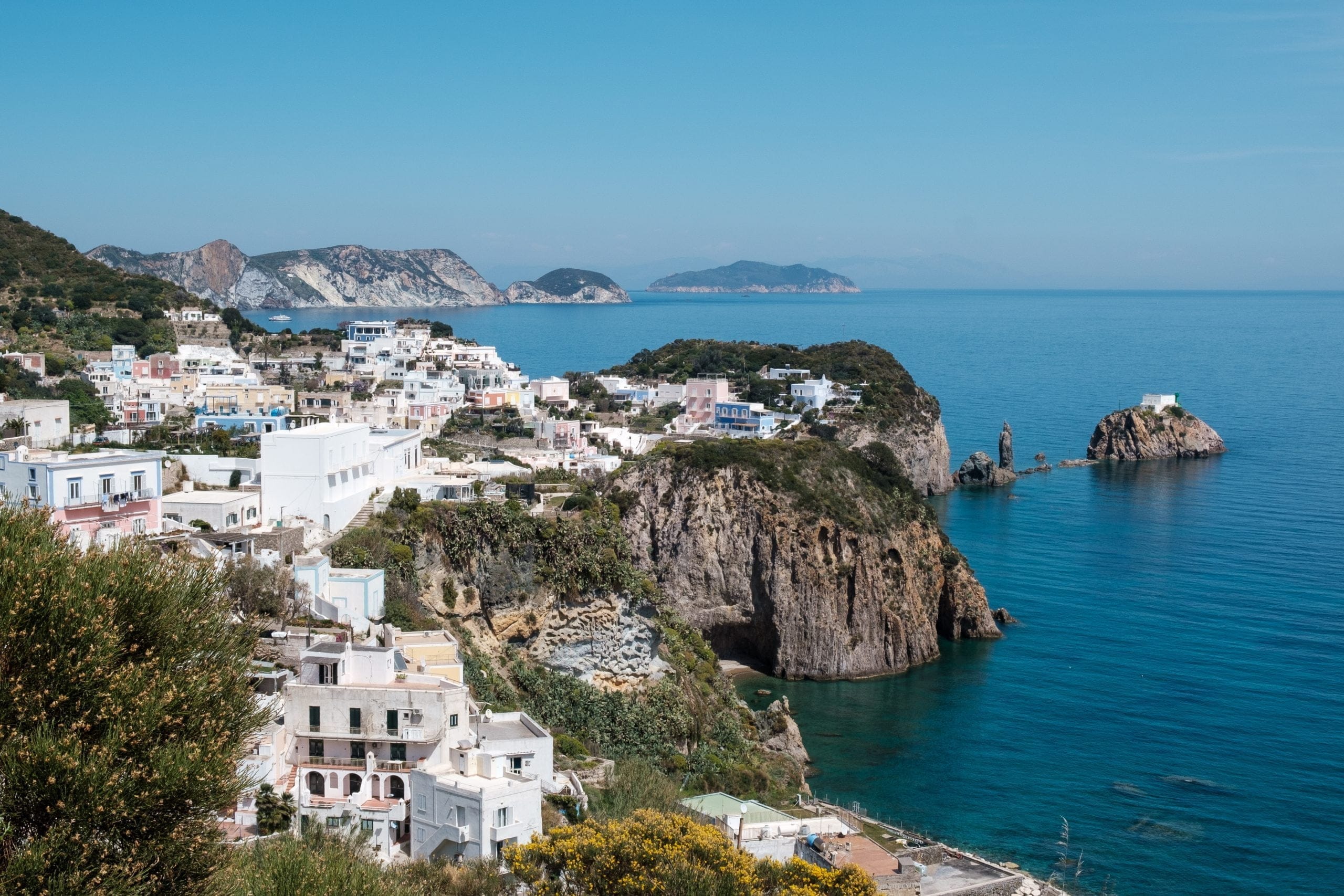
Tour of the 5 must-visit pontine islands
If you are in Ponza, you absolutely cannot miss visiting the other 5 Pontine islands that make up the Pontine archipelago. Gavi, Palmarola, Zannone, Ventotene and Santo Stefano are the perfect destinations for those who love seaside resorts, but also for those who want to immerse themselves in wild places that still preserve the authenticity of nature and traditions.
Let’s find out about these islands in more detail, but we warn you: you’re sure to fall in love with them!
We begin with the islands under the Ponza municipality administration, which are Gavi, Palmarola, and Zannone.
Gavi Island, the perfect destination for diving enthusiasts
We have talked extensively about what to do in Ponza so we take it for granted that by now you know the island like the back of your hand. Let’s start, then, from Gavi, a small island with rugged coastline where you can still breathe in the true wild charm of the Pontine islands. The beauty of Gavi is the fact that it is an almost entirely uninhabited island; the only people who inhabit it in the summertime are the owners of the only house in the area.
The island has no beaches, but this lack is made up for by the presence of wonderful seabeds of volcanic origin that diving enthusiasts will not fail to appreciate. The flora is very reminiscent of that of Ponza with the vegetation featuring mainly blueberry, broom, lentisk and agaves, while in the fauna reigns the herring gull, the peregrine falcon, which also nests here, and the Gavi lizard, which lives only on this island.
Gavi Island is accessible on two sides: a northern slipway that is in disuse and a southern slipway that is the main landing also for private or charter boats coming from Ponza.
Palmarola and its inaccessible beauty
If you are in Ponza, you cannot fail to carve out a day to go and visit the wonderful Palmarola. It is the largest of the islands that make up Ponza and the third largest of all the Pontine islands. Palmarola also preserves a wild and unspoiled nature made of cliffs and a lively vegetation, let’s not forget that its name would derive from a dwarf palm tree that grows wild on the island.
The preservation of its original appearance is due to the fact that Palmarola has no restaurants or accommodations. The only place dedicated to tourists is a hotel with a restaurant called O’ Francese. A place that retains all its initial authenticity, although substantial improvements have been made such as the inclusion of solar panels.
If you are wondering how to get to the island of Palmarola, know that you can take advantage of our rental with driver. We take you to discover the wonders of the island, and its majestic stacks, on our goiters equipped with everything you need to make you spend hours of true relaxation and, of course, with an experienced guide operating in complete safety.
Zannone: the green island, jewel of the Circeo National Park
Zannone is the northernmost island in thePontine archipelago and the smallest after Santo Stefano and Gavi. Already from the boat you will notice the lush vegetation that stretches across the island. Zannone, in fact, is uninhabited and the hand of man has arrived only in part. Here once stood the villa of Marquis Casati Stampa, which rose to the headlines for the scandalous parties held there, which were followed by the killing of his wife and mistress by the marquis and even his suicide.
Zannone’s charm comes precisely from the fact that it belongs to no one and is therefore all of those who visit it at that precise moment. Trekking enthusiasts will find plenty to do here. It is possible, in fact, to take long walks in the woods, among paths and ruins such as those of the Cistercian monastery, and in the Mediterranean maquis among myrtles, broom, holm oaks, strawberry trees and wild olive trees.
The only possible way to reach Zannone is to disembark at Varo; here it is not possible to moor the boat so it is necessary to be accompanied.
For those who only plan to go around the island, they can book one of our tours during which they can discover wonderful coves such as the Grottelle cove, the Monaco rock that seems to take on the physiognomy of a monk, the Calcara beach overlooked by the dolomitic, limestone cliff, and the Mariuolo cave.
Ventotene, an island full of history
Ventotene is the most touristy island compared to those mentioned above, albeit more discreetly than Ponza. Although it is frequented during the summer period, Ventotene, too, has managed to retain wild but more human-friendly elements.
Although it is part of the Pontine islands, geographically it is closer to the Phlegrean islands from which it has absorbed both culture and some environmental features such as dark beaches and tufa rocks. The Roman port is an example of this with its structure carved into the tuff where one can still see the berths where Roman ships were moored. Here the Romans also carved out a fishpond in the tuff with a special technology that allowed them to mix fresh and salt water and only let out water without the fish that were raised there. It is also possible to swim in the Roman fishpond and then go up to the rocks where the ancient salt pans were.
Ventotene is a place worth visiting for the artifacts and architecture that speak of history. Such as the Roman cisterns including the Cistern of Prisoners where you can still see murals made by the prisoners of the Bourbon era and the monks who lived there before them, or the Bourbon ramps that connect the Roman port to the historic center, the Bourbon castle, and much more.
St. Stephen’s, the prison island
We end our virtual tour of the Pontine islands with the small island of Santo Stefano, which lies 2 km off the coast of Ventotene. Its rugged coastline has always made it difficult to land there-in fact, it is completely uninhabited and the only structure there is the Bourbon prison in which President of the Republic Sandro Pertini was also imprisoned during Fascism.
If you want to make this tour a reality, book a boat tour from us at Fat Black! We will be happy to take you to discover the wonderful islands that make up the Pontine archipelago.



